#Greyhawk Adventures
Text

Game designer Jim Ward has passed away at age 72. He was the author of many early D&D titles and Dragon articles, including Supplement IV: Gods, Demi-Gods & Heroes for OD&D (1976) and Deities & Demigods for AD&D (1980), both with Rob Kuntz, and the AD&D book Greyhawk Adventures (1988).
He created the first sci-fi RPG, Metamorphosis Alpha (1976), and cowrote the thematically related Gamma World (1978) with Gary Jaquet. Anagrams of his name appear in Greyhawk lore as the mage Drawmij, a member of the Circle of Eight, and the Dramidj Ocean in the far northwest corner of the map.
#Jim Ward#James M Ward#gaming history#D&D#dnd#AD&D#Deities & Demigods#Drawmij#Dramidj Ocean#Gamma World#Greyhawk Adventures#in memoriam#Dungeons & Dragons#TSR#Greyhawk#Dungeons and Dragons
297 notes
·
View notes
Text

Greyhawk Adventures: Saga of Old City Cover Art by Clyde Caldwell
#Dungeons & Dragons#D&D#Greyhawk Adventures#Saga of Old City#Clyde Caldwell#Covers#Cover Art#Fantasy#Art#TSR#Wizards of the Coast
16 notes
·
View notes
Photo
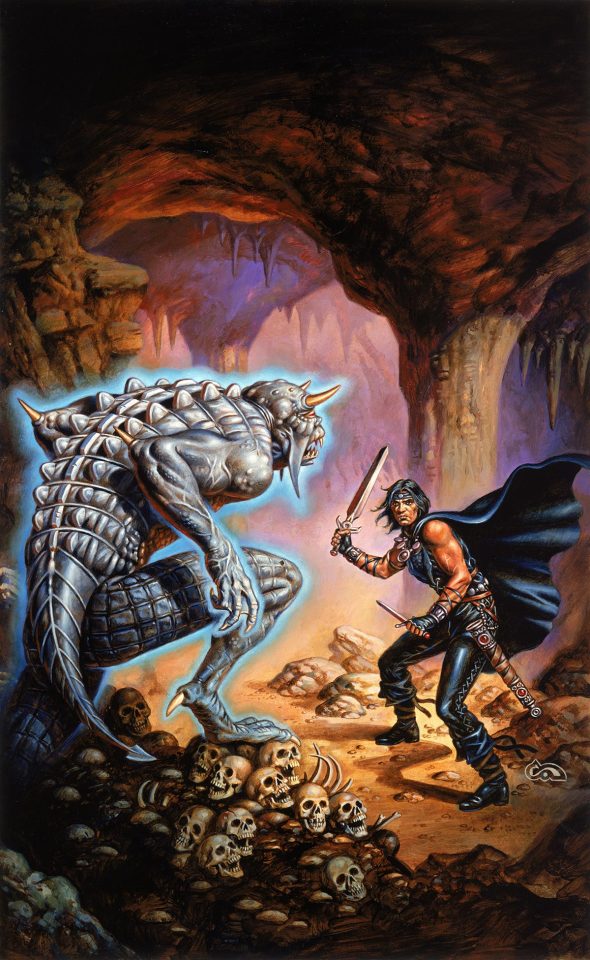
Saga of Old City by Clyde Caldwell, 1985
#saga of old city#clyde caldwell#painting#fantasy#fantasy art#illustration#vintage#1985#1980s#dungeons & dragons#greyhawk adventures
94 notes
·
View notes
Text


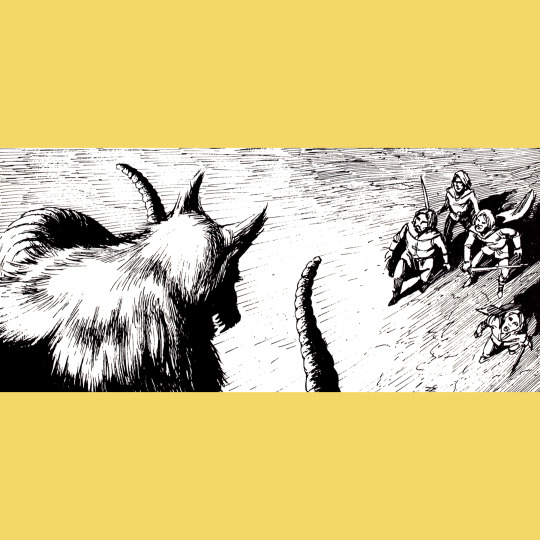

WG5: Mordenkainen’s Fantastic Adventure (1984) is a pretty old school adventure. Literally! Though adapted to the Greyhawk setting for publication, it actually draws primarily on a dungeon designed by Rob Kuntz for his Castle El Raja Key. Gygax experienced it as a player and it proved more than Mordenkainen was capable of (for a time, anyway). Considering that history, the framework of the adventure was likely around ten or twelve years before publication, making it a glimpse of an earlier time and design sense.
In the preface, Gygax calls it a hack and slash adventure, and that is pretty true. Three levels, all action. Lulls in the action are are punctuated by Tomb of Horrors-style death traps and the occasional puzzle (the initial entrance of the dungeon is one such puzzle, sealed with impossible to open doors). There’s a mad mage, there’s a demon, there are hints at a larger world of Greyhawk. There’s the option to play as some of Gary’s characters instead of bespoke PCs. Just the peak at Mordenkainen’s attributes feels somehow important.
It isn’t earthshaking, really, and I don’t love the climactic demon, but on the whole, I would probably pull this off the shelf if I wanted to run something in the “classic” mode. It has an energy that I like better than most of the more popular “classic” modules, though that might be thanks to over-familiarity. I certainly prefer it over Tomb of Horrors. The art package — a classic Caldwell cover and interiors by Easley — goes a long way in selling it, too.
#roleplaying game#ttrpg#tabletop rpg#dungeons & dragons#rpg#d&d#Greyhawk#Gygax#Mordenkainen's Fantastic Adventure
183 notes
·
View notes
Text
Leading the way in terms of awards was the much-anticipated Baldur's Gate, a fantasy role-playing game set in the world of Dungeons and Dragons.
-TLDR News Daily

#dungeons and dragons#dnd#D&D#dnd memes#baldur's gate#forgotten realms#eberron#dark sun#kingdoms of kalamar#dragonlance#ravenloft#ghostwalk#warlords of the accordlands#midnight rpg#weird war 2 blood on the rhein#swashbuckling adventures#oriental adventures#rokugan#al qadim#planescape#spelljammer#gamma world#mythic vistas#birthright#greyhawk#1985 Dungeons and Dragons cartoon#7th Sea#Mystara#legend of the 5 rings#scarred lands
10 notes
·
View notes
Text
Demon, Kerzit
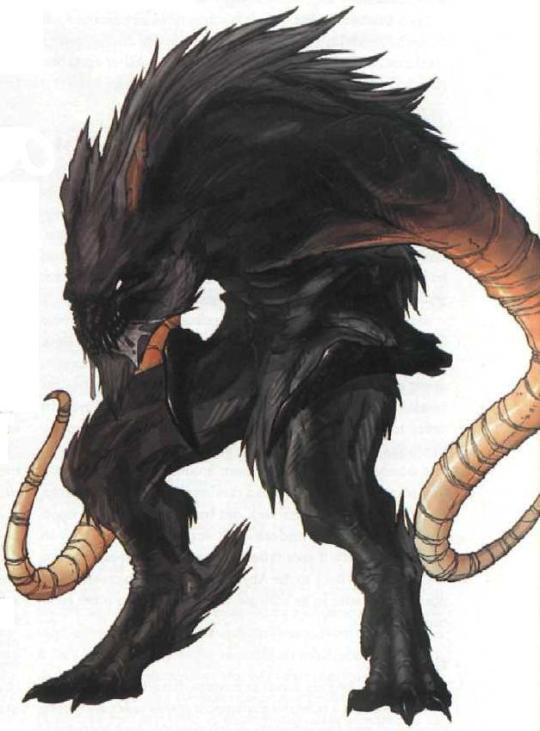
Image by Andrew Hou, © Paizo Publishing
[Commissioned by @tar-baphon. Kerzit the Guardian of the Black Tome first appeared in Mordenkainen’s Fantastic Adventure in 1984, was converted to 3.5 in Dungeon Magazine’s conversion of that adventure in 2004, and that’s about it. My third paragraph of flavor text refers to the events of the adventure, but feel free to ignore it if you want Kerzit somewhere else or working for a different cult. As written, he’s designed to be basically a decoy demon lord, and it is said in text that “several demon lords” conspired to make him. This is left vague in the text, but the presence of gnolls in MFA would suggest Yeenoghu in the Greyhawk cosmology, or Lamashtu in the Pathfinder version, would be a major player. Based on the commissioner’s request, I elevated the CR from 18 to 20, but didn’t have to do much in terms of increasing the power; the biggest changes to ability scores involved toning down a very high Strength.]
Demon, Kerzit
CR 20 CE Outsider (extraplanar)
This creature is a biped, with a wolfish head and silver eyes. Its coat is a shaggy mix of fur and feathers, matted and stained with blood and viler fluids. It has four arms, two of which are annulated tentacles, and two of which are insect-like and end with serrated blades.
Kerzit the Guardian is a powerful unique demon incorporating features of multiple scavenging animals—wolves, ravens, beetles and earthworms. Likewise, Kerzit scavenges bits and pieces of veneration from other demon lords. Kerzit was created long ago in a rare show of cooperation among the lords of the Abyss. The goal was to create a powerful servitor strong enough to fulfill mortal ambitions and act as a figurehead and sacrificial focus for cults venerating another, more distant demon lord. Kerzit has an ambivalent relationship towards these cultists; he views them as deluded and readily accepts them as sacrifices, but also hopes that their worship kindles a divine spark, transforming him into a nascent demon lord.
Kerzit enjoys fighting in melee, but is smart and subtle enough to try and learn about his foes first. Kerzit’s summoning abilities are more powerful than most other fiends, and he usually sends out a wave of lesser demons to scout for him and report back on enemy tactics. He targets divine spellcasters above other targets, and is immune to many of their weaker spells. One of his favorite strategies is to center a quickened, empowered unholy blight on himself while simultaneously shredding opponents with his teeth, talons and tentacles. Kerzit sees no shame in fleeing a losing fight through teleportation, but stays close, heals himself, and returns for a second bout after enemy spells have elapsed durations.
Kerzit is currently bound to the Material Plane via the Tome of the Black Heart, a demonology manual and ritual guide of great age and great power. The Tome contains information on constructing golems, contacting fiends and elemental spirits, and opening portals to esoteric and obscure demiplanes. This book was written by worshippers of Kabriri, whose scavenging through the memories of the dead unearthed a ritual to summon and bind Kerzit. The Tome of the Black Heart’s current owner is a mortal spellcaster obsessed with seeking out power through arcane knowledge. Kerzit keeps the book in his possession as a “matter of security”, and demands sacrifices of black opals and humanoid souls for the privilege of reading its pages, a price the amoral wizard is more than willing to pay. After a decade or so of service in this manner, Kerzit is growing bored, and relishes the opportunity to murder any intruders he comes across.
Kerzit CR 20
XP 307,200
CE Large outsider (chaos, demon, evil, extraplanar)
Init +6; Senses darkvision 120 ft., detect magic, Perception +33, see invisibility, scent
Defense
AC 36, touch 15, flat-footed 30 (-1 size, +6 Dex, +21 natural)
hp 372 (24d10+240)
Fort +17, Ref +20, Will +22
DR 15/cold iron and good; Immune electricity, fire, poison; Resist acid 10, cold 10; SR 31
Defensive Abilities reject divinity
Offense
Speed 30 ft.
Melee bite +34 (4d8+11/19-20 plus poison), 2 talons +34 (2d10+11 plus abyssal wound), 2 tentacles +32 (2d6+5)
Space 10 ft.; Reach 10 ft.
Special Attacks rend (2 tentacles, 2d6+16)
Spell-like Abilities CL 20th, concentration +26
Constant—detect magic, see invisibility
At will—darkness, greater teleport (self plus 50 lbs. objects only), telekinesis (DC 21)
3/day—fly, greater dispel magic, summon (7th level, 4 hezrous or 2 glabrezu, 60%), quickened empowered unholy blight (DC 20)
1/day—heal (DC 22), unholy aura (DC 24), weird (DC 25)
Statistics
Str 32, Dex 22, Con 29, Int 21, Wis 22, Cha 23
Base Atk +24; CMB +36 (+38 bull rush); CMD 52 (54 vs. bull rush)
Feats Awesome Blow, Blind-fight, Cleave, Combat Reflexes, Empower SLA (unholy blight), Great Cleave, Improved Bull Rush, Improved Critical (bite), Iron Will, Multiattack, Power Attack, Quicken SLA (unholy blight), Toughness
Skills Acrobatics +30, Climb +35, Intimidate +30, Knowledge (arcana, geography, history, planes) +32, Perception +33, Sense Motive +33, Spellcraft +29, Stealth +29
Languages Abyssal, Celestial, Common, Draconic, telepathy 100 ft.
Ecology
Environment any land or underground (Abyss)
Organization unique
Treasure double standard
Special Abilities
Abyssal Wound (Su) Wounds dealt by Kerzit’s talons deal 1d10 points of bleed damage. This bleed can be stopped with a healing spell or a DC 25 Heal check. However, any spell that heals hit point damage that affects a creature suffering from an abyssal wound must succeed a DC 31 caster level check or fail.
Poison (Ex) Bite—injury; save Fort DC 31; frequency 1/round; duration 6 rounds; effect 1d6 Con drain; cure 2 consecutive saves. The save DC is Constitution based.
Reject Divinity (Su) Kerzit is immune to any divine spell of 3rd level or lower that allows for spell resistance.
#kerzit#demon#commissions#greyhawk#pathfinder 1e#D&D#maure castle#mordenkainen's fantastic adventure
87 notes
·
View notes
Note
I was thinking about searching for Oriental Adventures because to my understanding it's not as much a setting as its a sourcebook for vaguely Postclassical East Asian settings, but I am kind of worried regarding Gygax's reputation. Like not everything that he wrote about non-European (or demi-human) cultures is horrible, at least not the way it was presented to me through second-hand sources, but plenty of things were, so like, is Oriental Adventures specifically horrible?
(Also from reading tvtropes for Greyhawk it apparently featured not only first instance of dark elves redemption but they weren't even inherently evil, just subjects of an evil god, and also while small an entire population of good orcs coexisting with humans, and that Gygax's plan was to dedicate more and more time to developing non-European regions. But also it mentioned that most orcs were even more monstrous than in mainstream fantasy, that the equivalent of South American civilisations was some kind of ancient degenerate empire and that Greyhawk had an equivalent of Indigenous people of North America who were an option for PCs but also it didn't say anything about them being treated respectfully so. Like obviously being racist is not aligning yourself with some gold standard of racism, people can be racist only towards certain groups or in more subtle ways, but this confusion is basically the reason I even consider searching for Oriental Adventures)
This is sadly way outside my wheelhouse because I haven't read Oriental Adventures 1e and even if I had I'm not the right person to critique whether it's good or bad or somewhere in between.
I did however remember having heard about an all-Asian TTRPG podcast having done a deep dive into it, and was able to find it pretty quick! I recommend you give them a listen! :)
youtube
As far as Gygax's own attitudes go, he was very opinionated about his own idea of what lawful and good meant in the universe of his game and in his opinion it could accommodate the killing of noncombatants provided they were "evil humanoids," and the justification for this was "nits make lice," which is a phrase historically used to justify the killing of Native children. This was in 2005 and the way the answer was framed was that this was his opinion of the way this issue would be seen in-universe, but the vibes are still off. I don't think this was necessarily an indication of his own moral outlook (he may have personally found these ideas abhorrent but considered that within the setting of the game these ideas would be accepted as aspirational), but even then the most charitable reading I can give it is that his way of articulating it was highly insensitive.
24 notes
·
View notes
Text
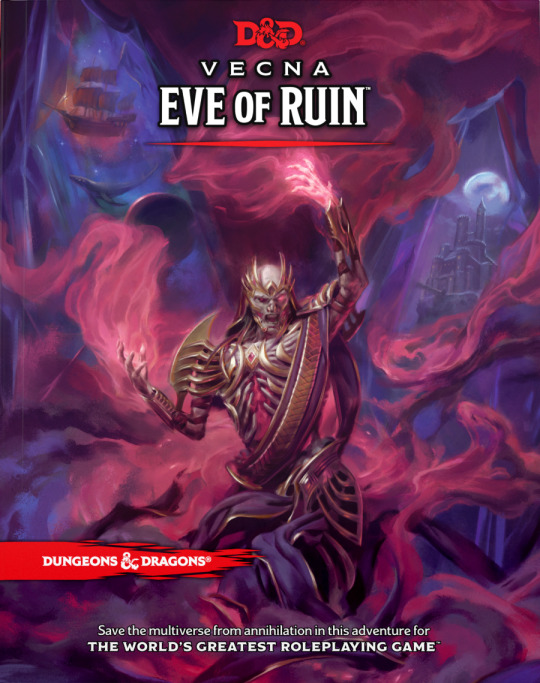
Vecna: Eve of Ruin
WHO WILL SAVE EXISTENCE?
Save existence from annihilation in this epic, multiverse-spanning adventure.
The notorious lich Vecna is weaving a ritual to eliminate good, obliterate the gods, and subjugate all worlds. To stop Vecna before he remakes the universe, the heroes work with three of the multiverse’s most famous archmages, travel to far-flung locales, and rebuild the legendary Rod of Seven Parts.
Vecna: Eve of Ruin is a high-stakes DUNGEONS & DRAGONS adventure in which the fate of the multiverse hangs in the balance. The heroes begin in the Forgotten Realms® and travel to Planescape, Spelljammer, Eberron, Ravenloft, Dragonlance, and Greyhawk as they race to save existence from obliteration.
A DUNGEONS & DRAGONS adventure for characters of levels 10–20.
GET AN EXCLUSIVE BONUS ADVENTURE
Prepare for the final battle with Vecna: Nest of the Eldritch Eye, a single-session adventure that foreshadows the events in Vecna: Eve of Ruin. This D&D Beyond exclusive releases 4/16 and is available with digital preorder only.
Vecna: Eve of Ruin, a 256-page hardcover adventure book for 10th to 20th level characters
Double-sided poster map
30+ Terrifying new monsters spawning from all over the multiverse
Detailed character dossiers with exclusive insights into legendary allies who you may recognize from other D&D adventures
D&D Beyond digital copy of Vecna: Eve of Ruin
PREORDER TO UNLOCK:
D&D Beyond access to Vecna: Nest of the Eldritch Eye, starting April 16, 2024
Early access to Vecna: Eve of Ruin on D&D Beyond, starting May 7, 2024
Hardcover – 21 May 2024, from Wizards of the Coast.
31 notes
·
View notes
Text
433. Gary Gygax - Oriental Adventures (1985)

A book which is really heavy on the text and light on the pictures (a characteristic of Gygax penned volumes, him being a man who never saw a word he didn't like), Oriental Adventures marks an important moment in the history of AD&D for a number of reasons.

In the first place, this is the first setting and set of rules not based on the Western European fantasy imaginary, drawing its inspiration from East Asia, particularly Japan but with elements of China and Korea thrown in, this also brings new mechanics to the game some of which (non-weapon proficiencies) would become staples of the game, while others (the honor system) would be pretty specific to this setting.

In second place, this volume gives birth to Kara-Tur, a campaign setting originally imagined as being part of Greyhawk, but which was published here as an independent setting, making it the fourth official original AD&D setting after Greyhawk, Ravenloft and Dragonlance (there were some non-original settings already such as Conan and Lankhmar and a semi-official one in Imagine magazine's Pelinore). Kara-Tur wouldn't last through the end of the decade as a stand-alone setting, eventually becoming part of the Forgotten Realms, later in the decade. A really interesting volume!

26 notes
·
View notes
Text
time for some dnd heavy theorizing about our beloved eddie, the banished

as we all know, we saw eddie die in the upside down, where his body was left. assuming this since there has been no proof of his death or whereabouts in the public eye. but what if there was a way he could be brought back? what if there was a way vecna brought him back?
there is a character in DnD named kas the bloody handed. he was once a human turned vampire during a battle against vecna, as his former first lieutenant turned betrayer. while i understand its not likely we will see eddie roaming hawkin’s as a vampire - this means that kas was at one point vecna’s puppet. all of the creatures in stranger things have their DnD counterpart who don’t LITERALLY have all the attributes of said counterpart. before eddie is killed by bats (a link to kas’ vampirism in DnD) he plays master of puppets by metallica. which you would think has no literal bearing on the story at hand... unless that is foreshadowing eddie’s fate in the upside down after death. eddie has bats tattooed on his arm, along with the master of puppets himself.

and not only that but while eddie is fighting and is eventually slain in the upside down, hopper picks up a sword which has a striking resemblance to the sword of kas. and imo there was a lot of emphasis on it as hopper picked it up off the ground... based on the prior fights that had happened in the pit there literally could have been anything there, an axe or WHATEVER. (there was actually nothing in the pit when joyce and hopper got down there so it almost seemed like it appeared in front of him, but that could be an oversight on the show productions part.) but THIS sword is what hopper picks up from the ground, as eddie is in the upside down keeping the bats off to the best of his ability.
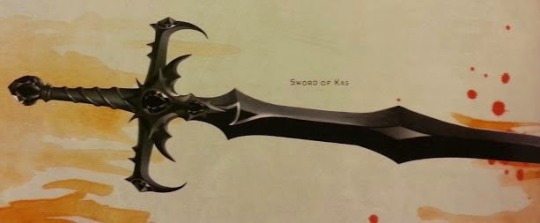

A BIT OF A RESEMBLANCE, NO? i’m going share some stuff from the kas section of the greyhawk wiki.
“Kas is perhaps best known for the infamous artifact that bears his name, the Sword of Kas. The Sword of Kas first appeared in the Original D&D supplement, Eldritch Wizardry. It was one of the first artifacts detailed for the Dungeons & Dragons game. The sword has been updated many times and has even been the object of quests as in the adventure Vecna Lives. The sword, variously described as a short sword, longsword, or greatsword, was crafted by Vecna. The blade is said to have been magically honed to a razor's edge, enhanced the wielder's strength, and could be used to call down lightning bolts from any storm clouds that might be overhead. The sword itself is intelligent, possessing a vile and murderous spirit. “
“After years of loyal service to Vecna, Kas eventually turned betrayer. It is said that the sword itself whispered to Kas, convincing him to slay his master and usurp his power. The battle destroyed Vecna's Rotting Tower, cost the lich his left hand and eye, and Kas himself was flung across the multiverse to Vecna's Citadel Cavitius on the Quasielemental Plane of Ash. The time he spent so close to the Negative Energy Plane changed him into a vampire, and he decided he would be called "Kas the Destroyer." “
eddie, the banished → eddie, the bloody handed → eddie, the destroyer
“When Vecna was defeated during his bid for control of Oerth, Kas was freed from his centuries of imprisonment, only to find himself facing a shapeless wall of mist. When it cleared, he was master of the domain of Tovag, across the Burning Peaks from Vecna's domain of Cavitius. Kas waged an endless war of attrition with Vecna's forces in the hopes of retrieving the Sword of Kas from Vecna's citadel, where he erroneously believed Vecna held it.”
“According to Dragon #341, when Vecna escaped from Cavitius, both realms were destroyed (explaining, in-fiction, their absence from 3rd edition Ravenloft). Kas was caught up in the destruction and very nearly obliterated; he survives only as a vestige, a soul outside time and space whose powers can be used by users of magic known as binders.”
i think there is a very high possibility we will see eddie munson, albeit changed, in season 5. there is also an additional theory linked to peter gabriel’s cover of “heroes” which plays in season one when it is believed that will has passed after his decoy body was found in the lake. this song also played after hopper “died” in season 3.. this song is also apparently heard after eddie has passed in the upside down. i’m not sure if this is confirmed because i was literally bawling my eyes out after and could have missed it so if anyone has an answer to this, please let me know!!
anyways with all of this symbolism it would be honestly pretty bonkers if it’s not true. this would give eddie a chance to fight in hawkin’s against vecna, in front of everyone, finally proving who he really was in life. even if at the end of it he is also destroyed. i know we all miss our boy and i just think this would be such a cool way to finish his arc as a true and known hero. which is what he DESERVES!


#eddie munson#st4 spoilers#stranger things 4#stranger things volume 2#stranger things theory#stranger things meta#stranger things#dungeons & dragons#vecna#kas the bloody handed#sword of kas
977 notes
·
View notes
Text
I saw @arendaes do this days ago and thought it seemed like fun (while I was also procrastinating), but after realizing I only had two portraits on hand I wound up spending more time than I should have putting together a third ^^;; Ash I hope you don't mind me tagging you despite all the time that's gone by!!

B A S I C S
Full name: Balthazar Lucienne
Gender: man (trans)
Sexuality: bisexual
Pronouns: he/him
O T H E R
Family: Kostas Stefanos (father), ??? (mother)
Birthplace: Absalom
Job: “traveler,” leader of a country
Phobia: being controlled
Guilty Pleasures: singing
Hobbies: fashion, esoterica, strategy games
M O R A L S
Alignment: CE
Sins: Pride, Greed, Envy
Virtues: Patience, Diligence
T H I S O R T H A T
Introvert / Extrovert
Organized / Disorganized
Close-minded / Open-minded
Calm / Anxious / Restless
Disagreeable / Agreeable / In between
Cautious / Reckless / In between
Patient / Impatient / In between
Outspoken / Reserved / In between
Leader / Follower / Flexible
Empathetic / Unempathetic / In between
Optimist / Pessimist / Realist
Traditional / Modern / In between
Hard-working / Lazy
R E L A T I O N S H I P S
OTP: Balthazar/Tristian, Balthazar/Vio
Acceptable Ships: idk I’m not picky lol
OT3: Vio/Balthazar/Tristian
Brotp: Balthazar & Jaethal

B A S I C S
Full name: Carmen Regis
Gender: woman (cis)
Sexuality: bisexual
Pronouns: she/her
O T H E R
Family: mother and father, Aunt Marcela, grandparents (maternal), grandmother (paternal), two other aunts and uncles, about seven cousins
Birthplace: Andoran
Job: knight errant, Knight Commander
Phobia: being lost
Guilty Pleasures: tea, a good book
Hobbies: n/a
M O R A L S
Alignment: LE
Sins: Pride, Wrath
Virtues: Patience, Diligence, Temperance, Humility (my hand didn’t slip.), secret extra Greyhawk answer is Chastity
T H I S O R T H A T
Introvert / Extrovert
Organized / Disorganized
Close-minded / Open-minded
Calm / Anxious / Restless
Disagreeable / Agreeable / In between
Cautious / Reckless / In between
Patient / Impatient / In between
Outspoken / Reserved / In between
Leader / Follower / Flexible
Empathetic / Unempathetic / In between
Optimist / Pessimist / Realist
Traditional / Modern / In between
Hard-working / Lazy
R E L A T I O N S H I P S
OTP: does toxic yuri count? In that case Carmen/Arueshalae all the way babyyyyy
Acceptable Ships: Carmen/Galfrey, Carmen/Daeran
OT3: I can't show you an OT3 but I CAN show you my toxic yuri love triangle where everyone loses in the end Carmen/Galfrey/Arueshalae
Brotp: Carmen & Greybor, Carmen & Ember (family!!), Carmen & her horse June

B A S I C S
Full name: Kasander / Asperia (keeping it simple and just them.)
Gender: nonbinary
Sexuality: asexual
Pronouns: they/them, any
O T H E R
Family: Orin (“sister”), Sarevok (half-brother), Bhaal (father), Helena (niece, deceased), Ismene (“half-sister”); Shadowheart (adoptive sister), Jaheira (adoptive mother)
Birthplace: Baldur’s Gate
Job: assassin/cult leader adventurer?
Phobia: Father, home, failure, abandonment
Guilty Pleasures: eavesdropping, dockside street food
Hobbies: lyre, people watching, theoretical plans
M O R A L S
Alignment: CG, CE
Sins: Gluttony, Envy, Pride
Virtues: Kindness, Humility, Diligence
T H I S O R T H A T
Introvert / Extrovert
Organized / Disorganized
Close-minded / Open-minded
Calm / Anxious / Restless
Disagreeable / Agreeable / In between
Cautious / Reckless / In between
Patient / Impatient / In between
Outspoken / Reserved / In between
Leader / Follower / Flexible
Empathetic / Unempathetic / In between
Optimist / Pessimist / Realist
Traditional / Modern / In between
Hard-working / Lazy
R E L A T I O N S H I P S
OTP: none <3
Acceptable Ships: cult leader breakup (derogatory), Kasander/Wyll
OT3: nothing comes to mind <3
Brotp: Kasander & Astarion, Kasander & Shadowheart, Kasander/Asperia & Jaheira
Not tagging anyone on this... if anyone would like to do it feel free to tag me haha
#I wrote the text for this days ago and am just trusting it's maybe right.#and this is the kas/asperia art I'd mentioned that will probably be the last here for a while haha. moving to the side blog.#I was a little too lazy planning that portrait and it does NOT match the style of the other two. whoops#balthazar lucienne#carmen regis#kasander#asperia#tag game#emi plays bg3#I said I'd tag things as a warning and I shall.
11 notes
·
View notes
Text
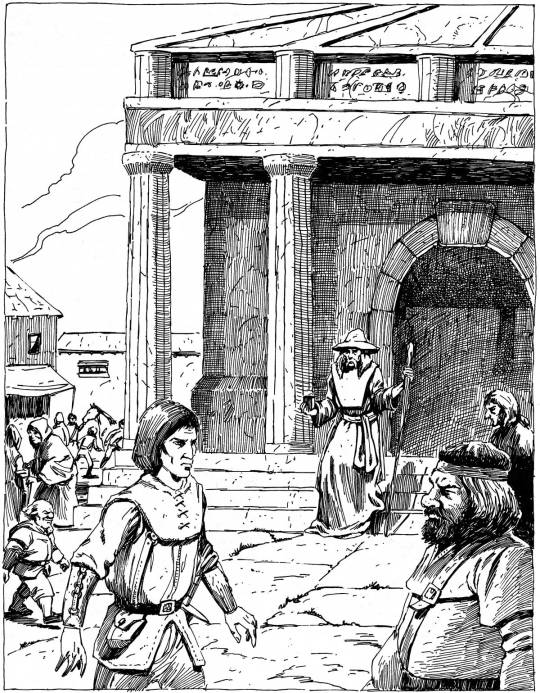
Old time religion -- A mendicant collects alms outside a temple in the Free City of Greyhawk. (Jeff Easley, AD&D supplement Greyhawk Adventures by Jim Ward, TSR, 1988)
In the world of Greyhawk the priesthood of St Cuthbert is divided into three orders: the Chapeaux, the Stars, and the Billets. All three orders have access to the beguiling spell, which imbues their cudgels with the power to charm one opponent by touch. The cleric may tap the target to help convert them to the faith, or attempt a damaging attack on a more incorrigible soul.
#D&D#Dungeons & Dragons#Jeff Easley#Jim Ward#James M Ward#St Cuthbert#Greyhawk#Greyhawk Adventures#AD&D#dnd#Dungeons and Dragons#temple#fantasy city#urban adventure#TSR
58 notes
·
View notes
Photo

Greyhawk Adventures - Artifact of Evil Cover Art by Clyde Caldwell
#Dungeons and Dragons#Dungeons & Dragons#D&D#Living Greyhawk#Greyhawk Adventures#Artifact of Evil#Fantasy#Art#Wizards of the Coast#TSR#Covers#Cover Art#Clyde Caldwell
22 notes
·
View notes
Note
My character learned to fight with staves and spears, what would it be better for her to take to a “DnD style” dungeon? (The world is similar to DnD world, although the spear is seriously underpowered in the rules)
So, I'm going to start with a couple nitpicks.
As someone with tabletop RPG experience, labeling it as, “D&D world,” is a really weird thing to read. D&D is primarily three distinct things. The rule systems themselves, and at this point we're up to the sixth or seventh major rules iteration. D&D as settings, except you'll almost never hear this one phrased that way. Finally, D&D as branding, which is extraordinarily nebulous, and tends to pick iconography out of the rules or settings. Simply identifying something as D&D could refer to any of these.
Officially, D&D has roughly 20 campaign settings. Any one of those could be categorized broadly as, “a D&D world.” Depending on the edition, the default setting is either Greyhawk or Forgotten Realms. These are entirely different worlds. Greyhawk is more of the conventional medieval fantasy world, while Forgotten Realms is a setting with mountains (in some cases, literally) of fallen empires, and the world is filled with ancient ruins, in addition to the current civilizations. Both of these are extremely detailed settings with thousands of pages of background lore.
Beyond that, Dragonlance, Dark Sun, Ravenloft, Planescape, Ravnica, Eberron, Spelljammer, and Urban Arcana, all come to mind as official TSR/Wizards of the Coast settings. And it's extremely likely that even players with an extensive familiarity with the ruleset missed at least one of the above names. This isn't even counting a lot of minor settings, or the fact that Planescape and Spelljammer are both multi-world settings, and the fact that a lot of these settings technically cross over. There are Spelljammer ports on Faerun (the main continent of Forgotten Realms), and races native to Planescape (in particular the Tieflings) have become a mainstay of the games, as they wander across the planes, to the point that Planescape's Tieflings and Aasimar exist in Pathfinder.
So, “The D&D world,” doesn't really say much.
With a lot of tabletop RPGs, the setting is analogous to the ruleset. When you're talking about running a Shadowrun campaign, or a Vampire: The Masquerade chronicle, those are specific worlds. The biggest ambiguity is which edition. However, when you say you're participating in a D&D campaign, that doesn't tell you much on its own.
If you're asking from a rules perspective, that's going to depend on the edition, and this is where stuff gets a little complicated.
If you're working with the idea of a D&D style dungeon, it's probably best to consider what era of game design you're looking at. There are a couple ways you can approach dungeons.
So, basic thoughts on dungeons.
Small dungeons are designed to be finished in a single session or two. You're probably looking at a few combat encounters. But, the main arc is that your characters travel to a dungeon, they do whatever they were planning to, and get out. You might have as many as four rooms, but generally these are pretty compact spaces.
Large dungeons can either be designed around the adventurers spending multiple days in the dungeon itself, or they may be traveling in and out and resting somewhere outside. (In some cases, you'll even have towns or inns set up over the dungeon. So your adventurers are all in one compact space.)
Additionally, large dungeons can be designed around the idea that the players will penetrate a few levels at a time, gradually working their way deeper over time (as they deal with other events and problems), or it can be a very long excursions, with adventures scavenging and hunting in the dungeon for days or weeks as they progress.
In the case of truly monstrous dungeons, they might even be bringing enough personnel and resources to set up various base camps and have a full supply lines running back to the outside world, as they gradually expand their control over the dungeon.
Sort of in parallel to this, it's worth thinking about what the dungeon is. The basic concept is often, as the name implies, some kind of semi-ruined castle prison. But, you'll also frequently see crypts, and caves as dungeons. Especially as small ones. At the same time, it's worth considering expanding your concept of a dungeon a bit. Ancient ruins, old fortresses, necropolises, abandoned mines, and sewers are common. (Sewers are a little unrealistic, as real ones don't tend to be massive underground pipes you can walk in.) What's less common are massive shipwrecks, overrun cities, entire islands with dangerous flora and fauna (or just pirates), fallen cities (where entire city districts collapsed during an earthquake and now exist below ground), plague ridden city districts (plagues can actually be a lot of fun, because it will let you transform familiar territories into hostile ones as the campaign progresses. Pathologic does this extraordinarily well.) In a rather famous D&D adventure (Expedition to the Barrier Peaks), one of the dungeons is a downed spacecraft. This is before we consider dungeons with impossible geometry, such as ones that leak over into another dimension (possibly as a result of magical experiments gone wrong, or ones that exist in the dreams or psyche of an individual. (For the record, I'm not a huge fan of psychic dungeons as a play experience, but they can be done well. I've simply had some bad experiences with the concept.) Shadowrun had a related concept, with cyberspace (called, “the matrix”), as a parallel space where hackers would engage in combat parallel to the events happening out in the real world. It's weird concept, but one that you might get some millage out of, and having a parallel battle on the astral plane wouldn't be that weird for D&D.
Moving beyond that, there are some semi-common dungeon settings that you don't often see in D&D, for obvious reasons, but might fit if your setting accommodates them. Abandoned research labs, abandoned industrial areas, abandoned villages or suburban areas at the edge of a city. Bonus points if the reason it's abandoned is related to why your players are wandering into it now. City districts under lockdown, usually this will either cater to a stealth focus, and might work if you have a group of thieves or something similar, (though, at that point, Blades in the Darkmight be a better RPG pick), this setting also works when the group enforcing the lockdown are acceptable targets, such as gangs or cultists, and for bonus points you can organize these setups with multiple factions and your characters may even be able to play groups against one another, all of this also works for feral cities (which also work as large area dungeons.)
With any dungeon, you probably want to consider how it fit into the world before it became a dungeon, and how long it existed as a dungeon before your players wandered in and started ripping the place apart.
So, ultimately, the question is about the spear and staff in the rules, as you're probably looking to approximate the rules to some extent. The problem is the rules have changed a bit over the years. One problem is that the default spear is not a reach weapon, meaning you can't use it to hit targets more than a space away from you. D&D splits that into the longspear, which is a reach weapon, and you can hit targets two spaces away from you, though you do need to use a 5ft step to back away from someone in an adjacent space before you can attack them. Both spears and staves are simple proficiency weapons though some editions do let you use the staff as a double weapon (meaning you can effectively treat it as dual wielding, if you have the feats.) If you do have a second attack with the staff, or you expect to be dealing with enemies that resist non-blunt damage (like skeletons) the staff starts to become a lot more attractive.
If you're using a different ruleset from standard D&D, there may be other considerations. I'm thinking of Total War's Anti-Large rules in particular, which do make spears very attractive against larger foes as they'll deal additional damage, similarly if you have some kind of homebrew piercing damage bonus against armor, that could make the spear conditionally more appealing. And, if your character is expecting to face down minotaurs or giants, then a longspear would be a much better choice with those modified rules. Though, this comes with another consideration, back in 3.5e the longspear was a simple proficiency weapon (just like the staff and spear), but was upgraded to martial proficiency in 4e, and seems to be missing in 5e (or it was replaced with the pike, which is also a martial weapon.) The longspear (and pike) do have special rules which allow them to be braced against a charging foe dealing increased damage. So, that might be worth considering for your choices. But, again, unless you're getting proficiency for the entire spear family, this might not be a practical option.
Usually, when you're arming characters for D&D, the primary consideration is going to be the overall thematic style of the character. Sometimes you do need to go out of your way to ensure a character gets the relevant proficiency (such as a rapier wielding wizard), but generally speaking, that theme is going to inform whether a character gets a spear or staff. If you've got a druid, then the spear might make more sense. If you have a wizard or sorcerer then maybe the staff is preferable (particularly if you can use it as an arcane focus.) (Though, wizards and sorcerers don't get spear proficiency in 5e, so, that's a factor.)
That said, you're not wrong, D&D has not done a good job with the spear. Part of that is because the default D&D spear is remarkably short. In 5e, the weapons are mostly interchangeable aside from the damage type, but the staff has more potential utility (specifically the ability to get staves crafted as arcane focuses, and a wider range of enchantments for staves.) Both are 1d6 with 1d8 versatile (if wielded with 2h the damage die is increased.) This is in contrast to 3.5 where the staff was 1d6, but was a double weapon, while the spear was 1d8, had the ready against charging characters action baked into the item (without the reach keyword), and had an increased crit multiplier (x3, meaning the weapon did triple damage on a crit, though it shared this with most axes), but it was a two-handed weapon.
I suppose if your character is a spellcaster, the staff is a better choice, as it gives you more options. But, when you're talking about someone who spends a lot of time out in the wilds, a spear might be a better thematic choice. If you're working within some version of 3rdedition, then the spear does look more valuable, but in 5e it is an underwhelming choice.
-Starke
This blog is supported through Patreon. Patrons get access to new posts three days early, and direct access to us through Discord. If you’re already a Patron, thank you. If you’d like to support us, please consider becoming a Patron.
49 notes
·
View notes
Text


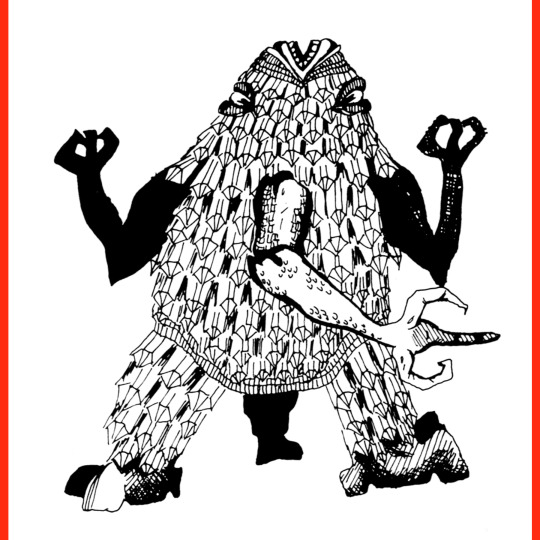


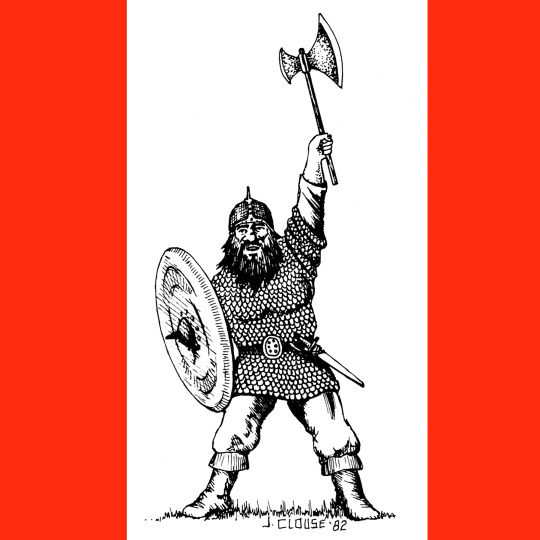
This is Dwarves (1982), the first of Mayfair’s Role Aids sourcebooks for D&D. It’s a little low rent but it is actually an example of outsiders understanding what early D&D players wanted better than the folks making D&D. The cover says this is an adventure, and there is one, and a bunch of adventure locations, but this is primarily a book of lore.
It’s pretty clear in the table of contents: “Chronology,” “Life in Ostohar,” “Religion,” “The Dwarven Rite” and so on — the book covers the history of dwarves, where they live and how they live in rich detail. We get gods, heroes, an explanation for their enmity with elves. Whereas in D&D at this point the only official knowledge about dwarves was their entry in the Players Handbook, and their entry in the Monster Manual. Noting that lack, the folks at Mayfair decided to fill in all the details they could.
This wasn’t unprecedented at the time. Cults of Prax came out in 1979, detailing the religions of RuneQuest’s various societies, and the Iron Crown’s Middle-earth books flesh out all aspects of the regions they presented. D&D had the World of Greyhawk map folio (1980) that gestures at this sort of worldbuilding without committing. More serious setting material from TSR would appear in the World of Greyhawk box set (1983) and in DL5, which is a sort-of sourcebook for the world of Dragonlance. Neither of these feel quite right in the way that Dwarves does for anyone who has ever read a ’90s era Forgotten Realms sourcebook. Dwarves and the other similar Role Aids sourcebooks nail the recipe that would dominate TSR’s approach to campaign settings and supplemental material from about 1986 until the death of the company. It’s weird!
Doubly so because Dwarves…isn’t really exciting. It’s a pretty conservative approach to dwarves the sticks to the genre clichés. You can only break so much ground at one time, I guess.
105 notes
·
View notes
Text
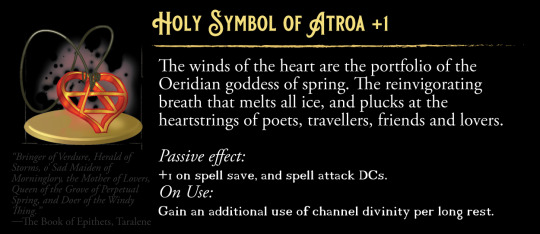
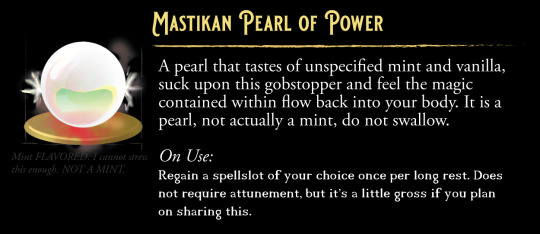

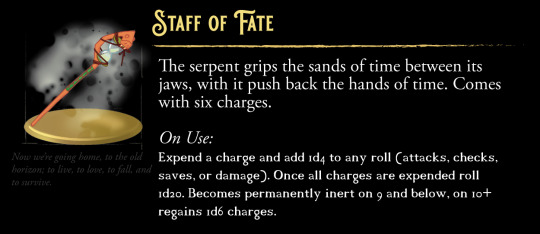

Some treasure party members acquired in a recent adventure. The Lyre of Building is of special note, being New Phyrexian in origin.
Though the symbol from Greyhawk is also groovy.
This is honestly the first time I've done mostly 'canon' trinkets.
#DnD#dungeons and dragons#domains of dread#decima#trinkets#greyhawk#phyrexia#new phyrexia#trinket#phyrexian#urabrask#wild beyond the witchlight
9 notes
·
View notes